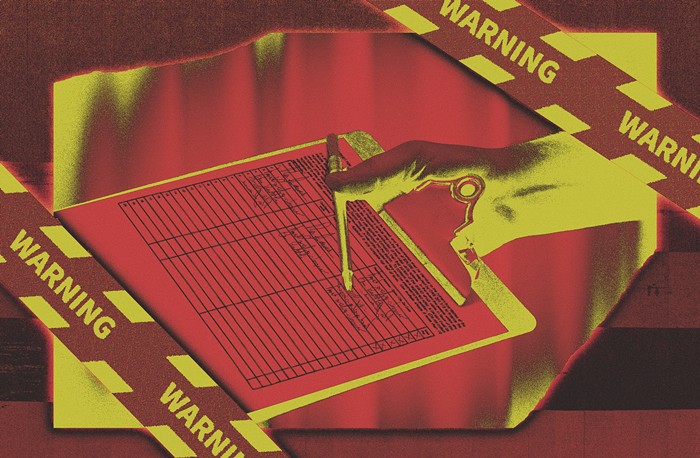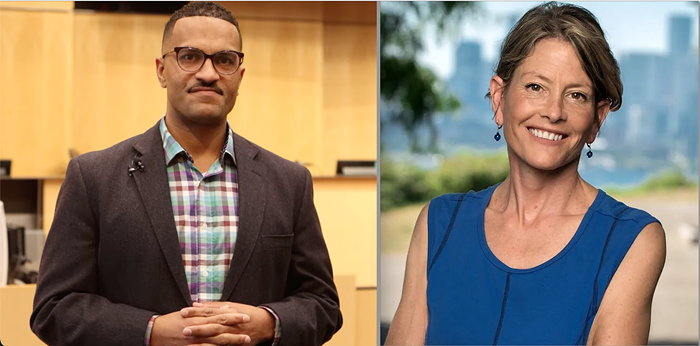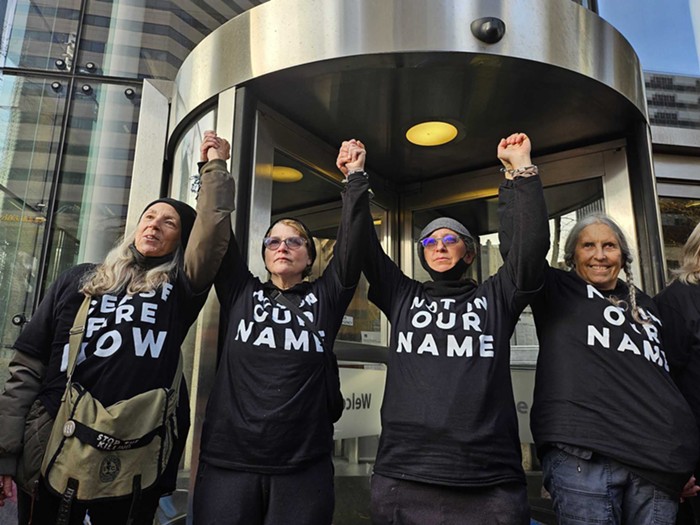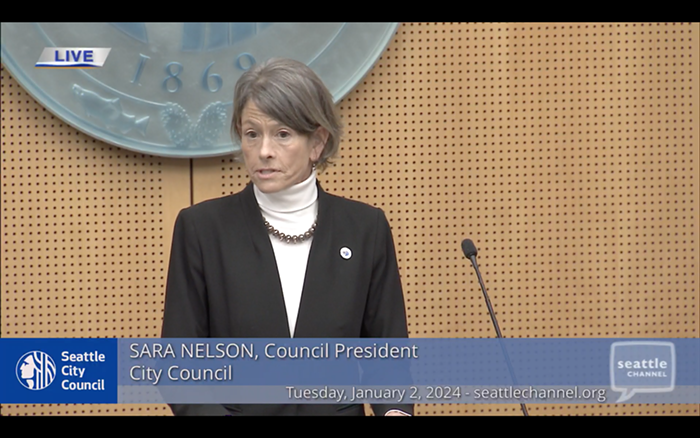AS THE MELTED-LOOKING GIRDERS went up over Seattle Center, the city had to hold its breath. Frank O. Gehry, the most prominent living architect, had been hired by Paul Allen, the third-or-so richest man in the world, to design a rock and roll museum called the Experience Music Project. What we'd seen were a few models, or newspaper photos of those models, that suggested a quintet of multicolored blobs casually dropped onto a flat surface like so many horse-droppings, with wires and banner forms strewn across the top like garlands. Notwithstanding Gehry's sculptural gifts, it was easy to worry a little, even a lot. The forms Gehry proposed seemed removed from any motive force, other than to suggest the remains of a smashed guitar, its strings slackly looping over the broken pieces. How this was all going to turn into a building that somehow resembled the models, yet would function as a working museum, nobody knew.
Now that the Experience Music Project is almost finished--it's scheduled to open with a Seattle Center-wide celebration on June 23--the project is starting to make a lot more sense. Questions over Gehry's ability to completely resolve the EMP's composition (or his decision to not do so) linger, but the building itself has become less important than its interaction with its surroundings--the Space Needle, the Monorail, and the loops of the small roller coaster in the amusement park directly behind it. Gehry is our most dramatic architect, creating the most center-stage of buildings, but he plainly understands how to share the spotlight with costars and stagehands alike.
But this is Seattle, a town built on bungalows in the neighborhoods and Richardsonian Romanesque in its old downtown. A city whose futuristic World's Fair gave us the Space Needle and the scaly, curving roof of the Coliseum (now KeyArena), while developers across town built a set of governmental buildings straight out of East Berlin and a sports stadium whose aesthetic expiration date was a mere 30 years after its completion. I'm not sure we have any business messing with architecture, and true to form, we've uncritically celebrated our conservative new concert hall and baseball stadium (designed by hometown folks) while warily regarding the L.A. guy (Gehry) and the Rotterdam guy (Rem Koolhaas, the designer of our soon-to-be new library) as people who might be out to hurt us. New forms are scary; new architects are scary, and we've been burned in the past. But our edginess seems born of ignorance. We are preparing to absorb two bold new buildings (the EMP and the library), and it's my dear hope that we'll individually or collectively judge them, but also be educated by them; that we'll better understand what the possibilities of architecture are, even if we reject the specific buildings.
MAKE IT NEW!
Frank Gehry's design for the EMP will not be repeated. Ever. Early carping that Allen and his sister Jodi Patton had simply commissioned an off-the-rack piece by a famous guy who was looking to coast on the commission was plain wrong. This is not a completely successful experiment, and it's highly unlikely that this will be remembered as his best work, or even his second best, after the Guggenheim Bilbao or some future Gehry building. But it's the work of a firm whose chief, even in his eighth decade, is still interested in moving beyond his past successes. In the eight years between 1989 and 1997, Gehry's complex, broken-up forms gained plasticity and elasticity. Each museum build- ing--the Vitra Design Museum in Germany (1989), the Weisman Art Museum in Minn-eapolis (1993), and the Bilbao (1997)--showed a burgeoning ability to open out the enclosing forms of walls and roofs. The sharp edges and slanting roofs of the Vitra were supplanted by the more organic, helter-skelter curves of the Weisman's metal-skinned Mississippi River-facing wall. By the time he was designing the Guggenheim, Gehry had learned how to organize the sharp and the soft into a breathtaking, comprehensive, singular building. Surface incident was absorbed into an overarching scheme; what seemed radical began to look sculptural. The world swooned.
I doubt the folks in Minneapolis or Weil am Rhein are complaining about their buildings, but they were clearly steps along a road; trial runs for new shapes. The EMP may be another step. The specific kinds of forms may not reoccur in his work again--I don't think he'll have another call to evoke a Fender Jaguar in stainless steel--but the direction he's moving in is a real new road, not a cul-de-sac. As Gehry's work matures, he broadens its scope, moving from surface experiments to complete buildings. The Weisman confined its experiment to a single wall (partly due to budgetary restrictions); most of its roof was a basic flat industrial style. At Bilbao, walls and roof join together in its French curve system, but you can still tell what's wall and what's roof. This distinction disappears entirely in the EMP design: It's either all wall or all roof, or, um, both! There are almost no sharp angles left; Gehry resolves his curves with other curves, molding formlessness into form with no recourse to traditional geometries.
There is one problem, though. When you look at the EMP, especially from a distance or from a high angle, as it appears in photos, the building never stops looking like five loosely connected masses in gold, blue, red, purple, and silver. It never looks exactly like a building. In more recent works, from a cottage in the U.K. to the model for the new Manhattan Guggenheim, Gehry has unified his structures with a tower; a central element that the other pieces can sprawl around, ooze over, float past. The blobs at Seattle Center certainly don't float; they rest firmly on the ground. The central tower (the purple exterior of the "Sky Church") is barely higher than the structures extending out from it, and thus it can't hold them together effectively.
Gehry wanted to blend his colors at the edges of the five structures, to mix some gold in with the blue tiles, to corrupt parts of the pure silver aluminum with some red or purple, which would have forced the structures into a closer relationship. The clients objected, as was their right (and it's understandable; presented with a mess, you might start thinking about ways of keeping it from getting messier), but I think they were mistaken. The restriction kept the forms from intersecting more completely; in fact, it makes the building messier.
Still, in its real-life setting--the true test for any building--the structure does work. The EMP hugs the Fifth Avenue sidewalk, giving incident and life to that stretch of pavement. Behind it, the formerly sprawling "Fun Forest," Seattle Center's small amusement park, has been effectively contained by Gehry's rippling but continuous and linear wall. The mottled purple of the "Sky Church" makes the petty state-fair-style rides more dramatic and beautiful. The Space Needle, standing alone for almost 40 years as a tribute to Seattle's forward-thinking aspects, finally has an architectural mate at its feet. And the main corner of Seattle Center, the one facing downtown, is finally a true entrance to what, let's admit, is a swell place.
Swoopy SymbolismAsked to create a museum of rock and roll, and asked by Paul Allen specifically to give him something "swoopy," Gehry started, appropriately enough, with a guitar. Twentieth-century architecture has generally shied away from overt imagery, for a number of reasons. First, it reeks of ornamentation, which after being famously attacked by Adolf ("Ornament and Crime") Loos, was seen in all its forms as bourgeois frippery, wasteful and pointless. Imagery in this era has a further taint of lowbrow oversimplification: The idea of a building that looks like an object quickly brings to mind a hot-dog-shaped hot-dog stand or a coffee-pot-shaped coffeehouse--not an association most high-end architects want to evoke.
For Gehry, however, the form of a fish--a carp, specifically--was the catalyst in his transformation from a gifted, semi-outsider oddball to his current position as our most celebrated living architect. Looking for a way out of the foursquare commonplaces of modern architecture, he turned to the form of a carp in a series of sculptures and small structures, and also when designing the Guggenheim Bilbao--finding inspiration in its complex curving forms and movement, and developing a wholly new form of architecture.
Well, not wholly new. Jacob Weisberg of Slate is correct to write "Gehry's fish is a savior, a perfect organic form that rescues architecture from modernist sterility," but Gehry's architecture is not without modernist precedent. Gehry readily admits his love for Erich Mendelsohn's 1920 Einstein Tower (of which Leonardo Benevolo wrote, "Mendelsohn had in mind a form that would give the instantaneous impression of a fluid mass"). Gehry also doesn't completely shun comparisons between his buildings and Eero Saarinen's eagle-like TWA Terminal at JFK Airport, Le Corbusier's hat-like Notre Dame du Haut at Ronchamp, or the molten forms of Barcelona architect Antoni Gaudí.
Two things, however, separate Gehry's work from those of his predecessors. One is simple history, which has deemed those great works odd offshoots of the main body of modernist architecture, which followed Ludwig Mies van der Rohe's "form equals function" and "less is more" concepts to their own particular dead end, then sought salvation through Classical ornament--pillars, cornices; all that dead Roman shit. By returning to an unfollowed path, Gehry moved beyond that whole debate, as if he went back into history, picked a spot, and went off in a new direction, a separate universe where the weight of modern tradition no longer existed.
The other factor separating Gehry from history is technology, which architecture hasn't made many demands on since the development of steel frame construction and reinforced concrete. Gehry's work since the early '90s is highly dependent on computers, particularly a piece of engineering software called CATIA. It's not so much that the software allows him to conceive of his forms, though they're certainly easier to manipulate in a virtual arena, but rather it allows his works to be easily transferred from idea to physical form. Gehry says the EMP is the first building to have moved from plan to building without requiring paper. The structure of the museum, which is revealed throughout most of its interior, rests on crazily bending plasma-cut I-beams that would be very difficult to spec without computers. Atop them is a concrete shell, with drainage systems on its surface, then the sheathes of colored stainless steel and aluminum, which, luckily, don't have to keep rain off the shell. (Gehry will proudly tell you that the Guggenheim Bilbao, unlike the Frank Lloyd Wright Guggenheim--unlike most of Wright's work, for that matter--does not leak. Neither, I hope, will the EMP.)
Key to Gehry's selection of source imagery is a kind of flux: Can the building that looks like a fish also look like a ship, or is it just going to be a fish? With the EMP, Gehry mixes his metaphors to good effect. He started with a pile of cut-up guitars (particularly Fender Stratocasters and Jaguars, but there's a Gibson and Gretsch look to the gold and silver parts of the building), but he was thinking of other things at the same time, like pickup trucks. (He wanted the red portion of the building to fade over time, like the finish on an old American pickup, but his client didn't want a faded building, so it's been given a clear protective finish that will allow it to hold its tone.) In short, the guitars are sometimes cars.
The sets of roller-coaster-like curving parallel pipes atop the building also refuse to resolve into a single form. First off, they're the strings that persistently connect the pieces of Hendrix's Stratocaster after he's bashed the body free of the neck. But Gehry's also had them covered with an array of small glass panes in blue, green, and clear. The panes are attached to the pipes at one edge, angling above it like scales. I mentioned Gehry also likes snakes, right?
Finding a form for a museum devoted to rock is a difficult task. Rock requires little from architecture, other than cheap rent, good locks, and isolation from noise-sensitive neighbors. The architectural forms associated with rock and roll are garages, basements, industrial buildings; all walls soundproofed with scraps of carpet and egg cartons. Commissioned to design the Rock and Roll Hall of Fame in Cleveland, Ieoh Ming Pei settled on a turntable, itself a museum piece, as his main symbolic form. But his turntable has no suggestion of movement. Gehry's building can suggest the chaos of rock, and suggests its primitivism by leaving the ceilings unfinished; steel beams and concrete shell completely visible. Beyond that, it's better that the building doesn't try too hard to evoke the rock milieu. In that direction lies the corrugated-metal-covered outsized "shack" of the House of Blues on Sunset Boulevard.
Frank O. Gehry, UrbanistA Gehry building wouldn't at first seem a natural fit within an urban context. One imagines his buildings standing alone, isolated from other buildings, like a sculpture in a park. But Gehry's complex curves tend to need anchors, which he realizes. His best work happens in para-urban spaces: at the edge of a city; by the water, as in his two Guggenheim designs; or set in a park-like space where the regular urban street-grid is interrupted, as in his set of buildings for the MIT campus or his work here at Seattle Center. I like to imagine Gehry's organic curves extruding out between a pair of modernist office towers, but he has yet to make a satisfactory urban interruption on the order of Christian de Portzamparc's new LVMH Tower on 57th Street in Manhattan, whose faceted planes of glass panels question the dull logic of the staid modern highrises on either side of it. Gehry's unrealized design for a Times Square building for Warner Brothers--which reconceived a wedge-shaped building as a fun-fair, with Wile E. Coyote and Bugs Bunny zooming in and out of the building on tracks--could have nailed this urban approach.
But if Gehry hasn't yet figured out the pure urban context, he's done wonders with urban edges, where isolated transportation systems like bridges and highways create dramatic possibilities. In Bilbao, his building's ship hull form dips gracefully under a bridge, arcing up on the other side to complete the effect of a ship's prow, and linking the building with the systems around it. Gehry found a similar transportation playmate at Seattle Center, in the form of the Monorail. The original site of the EMP started just north of the Monorail tracks; it was Gehry's genius to extend the site south and wrap the building around the tracks. Gehry's interplay with the Monorail is the finest piece of his design for the EMP.
Here we find Gehry's most dramatic use of mixed symbols. Alongside the tracks, the passing trains appear to have blown open Gehry's forms. As the silver building nears the tracks, its rounded shape suddenly seems to rip apart; on the other side of the building, the blue form over the tracks billows out, rippling as if a curtain had been ruffled by wind. The fixed object that is the building gains a sense of motion, flux; the beauty of a fish moving through water--but it's not a fish.
Fish, guitar, or curtain; the building's form is just a starting point. It will have to grow into its role in the city. Paul Allen can cut a check for $100 million, but it takes people (tourists and citizens alike) to make the building a success or failure. The EMP will prove its worth over time, and through use. Will the exhibits inside be fun, silly; will they relate effectively to pop music, overly enshrine it, reduce it to a funhouse? Will the building be a landmark; will it be loved; will people like walking by it? Will people get how it relates to the Space Needle, the Monorail, and the roller coaster behind it? Will it hold up physically and aesthetically over time? Will people want to go there? I have only hints of these answers. I will say that this building is no embarrassment; no Gehry bought straight off the shelf. It's an intense effort to explore some difficult ideas. And it will be a continuing source of interest and education, and hopefully joy, as it becomes part of the history of this city.


















